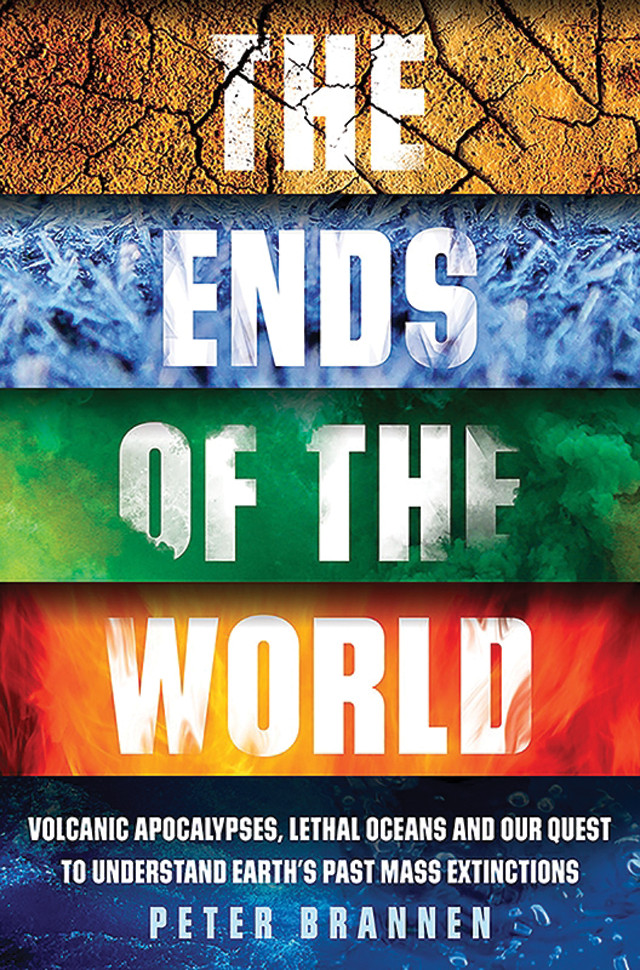
by Callan Bentley Wednesday, February 13, 2019

"The Ends of the World: Volcanic Apocalypses, Lethal Oceans, and Our Quest to Understand Earth's Past Mass Extinctions," by Peter Brannen, Ecco/Harper-Collins, 2017, ISBN 9780062364807; paperback published 2018, ISBN 9780062364814
Our planet has been through some harrowing episodes, particularly in the form of mass extinctions since the advent of multicellular life. How organisms came to perish in these events should interest all conscious, intelligent forms of multicellular life lucky enough to still be alive — you and I included. A great way to satisfy that interest is with “The Ends of the World: Volcanic Apocalypses, Lethal Oceans, and Our Quest to Understand Earth’s Past Mass Extinctions” by Peter Brannen, a well-paced, well-sourced and well-written guide to mass extinctions.
There have been five “big” mass extinctions in geologic history — times when at least half of the species on the planet died out permanently in a relatively short span of time. The 50-percent criterion is arbitrary, but it’s pretty severe — more so than what we’ve seen so far in the current episode of environmental diminution. These were hard times on the third rock from the sun, sometimes due to extreme cold or heat, and sometimes due to more complex causes. For example, Brannen looks at the role plate tectonics plays in extinction. The formation of supercontinents facilitates competitive extinctions by mixing species whose ecological niches overlap. And isolated continental fragments reduce escape routes, which can also cause the demise of species. Earth’s oceans play a huge role too: If continental shelf environments remain well-oxygenated, all is well. But if the oceans go stagnant, expect things to get lethally stinky.
Brannen is a journalist who is passionate about finding out the whole scientific story and explaining it in measured, accessible language. One strength of the book is that it’s informed by the dozens of interviews Brannen conducted with scientists in the course of his research. He consulted experts on all aspects of the science and gives voice to divergent opinions where they exist, and to unanimity elsewhere. The book is also filled with pithy quotes and conversations.
“The Ends of the World” seamlessly covers the basics of geology. Key foundational concepts are covered surely and efficiently, never for their own sake but, rather, always on the way to some exciting and curious insight. Take Brannen’s explanations of isotopic studies, for example. An increasing number of insights about our planet’s deep history are being revealed by these atoms of varying masses, but unlike fossils, isotopes are invisible, and they are hard to write about compellingly. Brannen uses straightforward language, explains the various fractionating processes that divide isotopes into different reservoirs and quickly gets to the point we care about: what isotopes can tell us about the drivers of past extinctions.
Throughout the book, Brannen weaves an alert consciousness of the planet’s modern state into his discussions of past events. He writes with great authority about environmental issues, in particular the historically unprecedented transfer of carbon from Earth’s sedimentary rocks into its atmosphere. He frequently draws explicit connections between ancient climatic chaos and our modern situation. This has the effect of investing the reader in caring about the end-Ordovician or end-Triassic extinction events in ways more profound than simply gawking at the death and destruction of sexy beasts like dinosaurs. We study extinctions of the past to better understand our present, and to prepare for our future. Are we living through a “Sixth Extinction”? Brannen investigates this question in great depth, documenting the declines of many large mammals that occurred when they came into contact with early people. But he also discusses whether these declines constitute a mass extinction based on standard scientific metrics — specifically, for example, species counts of marine invertebrate fossils. As it turns out though, it’s kind of tricky to apply the usual metrics to the modern situation. A useful discussion follows on the art of comparing modern to ancient.
He also gives substantial attention to “the final mass extinction” — the anticipated end of life on our planet in the distant future. Though this is (hopefully) billions of years off, it turns out you can learn a lot about it based on what we know about solar physics and geochemical cycles on Earth. This is a topic I’d never read about before, and Brannen does a great job of exploring it in the context of the mass extinctions in our past.
Beyond the fascinating science, the book is a delight to read. Brannen is funny. He asks, “Why do bad ice ages happen to good planets?” and calls placoderms (extinct, heavily armored fish with sharp jaws) “psychotic torpedo Cuisinarts.” These lively turns of phrase engage the reader, leaving you wondering what his next witticism will be. The Permian was “a synapsid-eat-synapsid world.” Gorgonopsids had “skulls like gigantic staple removers.” Readers will smile frequently.
Brannen’s language is evocative and fresh, emblematic of his novel take on the subject. For instance, in detailing how a massive wad of basalt erupted in what’s now Siberia at the end of the Permian, he steers clear of repeating the oft-used description about “floods” of lava, and instead states that “Siberia turned inside out.” Another example is his description of humanity’s ability to transfer gobs of carbon from Earth’s interior to its atmosphere as a “superpower” previously exhibited only by flood basalts. His contemplation of our place in all of this is poetic as well as awe-inspiring. In short, it’s a treat to read his words.
This comprehensive book is the best I’ve read on mass extinctions and constitutes a major contribution to public understanding of the subject.
© 2008-2021. All rights reserved. Any copying, redistribution or retransmission of any of the contents of this service without the expressed written permission of the American Geosciences Institute is expressly prohibited. Click here for all copyright requests.